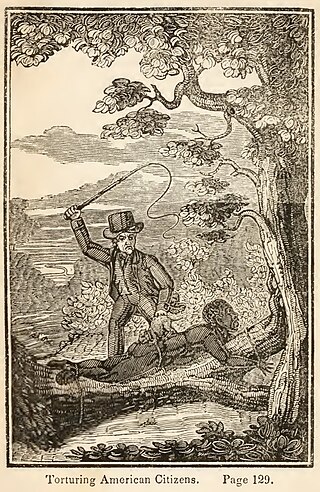
The legal institution of human chattel slavery, comprising the enslavement primarily of Africans and African Americans, was prevalent in the United States of America from its founding in 1776 until 1865, predominantly in the South. Slavery was established throughout European colonization in the Americas. From 1526, during the early colonial period, it was practiced in what became Britain's colonies, including the Thirteen Colonies that formed the United States. Under the law, an enslaved person was treated as property that could be bought, sold, or given away. Slavery lasted in about half of U.S. states until abolition in 1865, and issues concerning slavery seeped into every aspect of national politics, economics, and social custom. In the decades after the end of Reconstruction in 1877, many of slavery's economic and social functions were continued through segregation, sharecropping, and convict leasing.

The Colony of Rhode Island and Providence Plantations was one of the original Thirteen Colonies established on the east coast of America, bordering the Atlantic Ocean. It was founded by Roger Williams. It was an English colony from 1636 until 1707, and then a colony of Great Britain until the American Revolution in 1776, when it became the State of Rhode Island and Providence Plantations.

Samuel Hopkins was an American Congregationalist theologian of the late colonial era of the United States. Hopkinsian theology was named for him. Hopkins was an early abolitionist, saying that it was in the interest and duty of the U.S. to set free all of their slaves.

The fugitive slave laws were laws passed by the United States Congress in 1793 and 1850 to provide for the return of enslaved people who escaped from one state into another state or territory. The idea of the fugitive slave law was derived from the Fugitive Slave Clause which is in the United States Constitution. It was thought that forcing states to deliver fugitive slaves back to enslavement violated states' rights due to state sovereignty and was believed that seizing state property should not be left up to the states. The Fugitive Slave Clause states that fugitive slaves "shall be delivered up on Claim of the Party to whom such Service or Labour may be due", which abridged state rights because forcing people back into slavery was a form of retrieving private property. The Compromise of 1850 entailed a series of laws that allowed slavery in the new territories and forced officials in free states to give a hearing to slave-owners without a jury.
The Free African Society (FAS), founded in 1787, was a benevolent organization that held religious services and provided mutual aid for "free Africans and their descendants" in Philadelphia. The Society was founded by Richard Allen and Absalom Jones. It was the first Black religious institution in the city and led to the establishment of the first independent Black churches in the United States.

Partus sequitur ventrem was a legal doctrine passed in colonial Virginia in 1662 and other English crown colonies in the Americas which defined the legal status of children born there; the doctrine mandated that children of slave mothers would inherit the legal status of their mothers. As such, children of enslaved women would be born into slavery. The legal doctrine of partus sequitur ventrem was derived from Roman civil law, specifically the portions concerning slavery and personal property (chattels), as well as the common law of personal property; analogous legislation existed in other civilizations including Medieval Egypt in Africa and Korea in Asia.
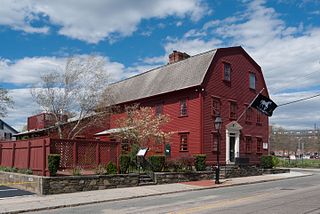
The history of Rhode Island is an overview of the Colony of Rhode Island and Providence Plantations and the state of Rhode Island from pre-colonial times to the present.

Daniel Coker (1780–1846), born Isaac Wright, was an African American of mixed race from Baltimore, Maryland. Born a slave, after he gained his freedom, he became a Methodist minister in 1802. He wrote one of the few pamphlets published in the South that protested against slavery and supported abolition. In 1816, he helped found the African Methodist Episcopal Church, the first independent black denomination in the United States, at its first national convention in Philadelphia.

In the American Revolution, gaining freedom was the strongest motive for Black enslaved people who joined the Patriot or British armies. It is estimated that 20,000 African Americans joined the British cause, which promised freedom to enslaved people, as Black Loyalists. Around 9,000 African Americans became Black Patriots.
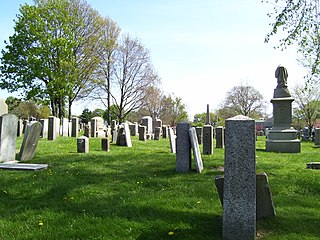
The Common Burying Ground and Island Cemetery are a pair of separate cemeteries on Farewell and Warner Street in Newport, Rhode Island. Together they contain over 5,000 graves, including a colonial-era slave cemetery and Jewish graves. The pair of cemeteries was added to the National Register of Historic Places as a single listing in 1974.

TheNewport Mercury, was an early American colonial newspaper founded in 1758 by Ann Smith Franklin (1696–1763), and her son, James Franklin (1730–1762), the nephew of Benjamin Franklin. The newspaper was printed on a printing press imported by Franklin's father, James Franklin (1697–1735), in 1717 from London. The Mercury may be the first newspaper published by a woman in the colonial United States. The Mercury was the also first paper to publish poetry by an African American woman, Phillis Wheatley.
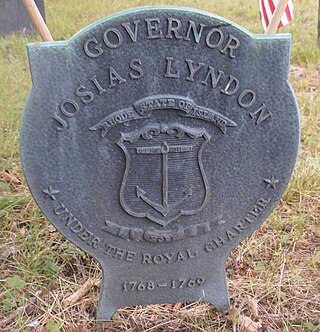
Josias Lyndon was a governor of the Colony of Rhode Island and Providence Plantations, serving for a single one-year term.

Mount Zion Cemetery/Female Union Band Society Cemetery is a historic cemetery located at 27th Street NW and Mill Road NW in the Georgetown neighborhood of Washington, D.C., in the United States. The cemetery is actually two adjoining burial grounds: the Mount Zion Cemetery and Female Union Band Society Cemetery. Together these cemeteries occupy approximately three and a half acres of land. The property fronts Mill Road NW and overlooks Rock Creek Park to the rear. Mount Zion Cemetery, positioned to the East, is approximately 67,300 square feet in area; the Female Union Band Cemetery, situated to the West, contains approximately 66,500 square feet. Mount Zion Cemetery, founded in 1808 as The Old Methodist Burial Ground, was leased property later sold to Mount Zion United Methodist Church. Although the cemetery buried both White and Black persons since its inception, it served an almost exclusively African American population after 1849. In 1842, the Female Union Band Society purchased the western lot to establish a secular burying ground for African Americans. Both cemeteries were abandoned by 1950.

In the United States, abolitionism, the movement that sought to end slavery in the country, was active from the colonial era until the American Civil War, the end of which brought about the abolition of American slavery, except as punishment for a crime, through the Thirteenth Amendment to the United States Constitution.
Duchess Quamino was a formerly enslaved woman who became famous in colonial Rhode Island for her success as an independent caterer. She was known as the "Pastry Queen of Rhode Island," particularly famous for her frosted plum cake.
Kingston Pease, was a property owner and prominent member of the free Black community of 18th-century Newport, Rhode Island. Along with Newport Gardner, Zingo Stevens, and Caesar Lyndon, Pease formed the Free African Union Society in 1780. In 1789, he was excommunicated from the Second Baptist Church for having a child with Anne Mackumber, a white woman.

Caesar Lyndon was a highly literate Black man enslaved by Josias Lyndon, known for his Sundry Account Book, a valuable historical record of life in Colonial Rhode Island. Caesar carried out Lyndon's business, acting as a purchasing agent and a secretary. His Sundry Account Book chronicles his financial transactions from Newport's famed slave traders like Aaron Lopez, as well as free and enslaved people. By way of double-entry bookkeeping, Caesar itemized the sale and acquisition of goods and services. He also noted deaths, marriages, and a pig roast. This nearly thirty-five-page book represents a lesser-known but fascinating example of the early African American literary tradition of the United States.
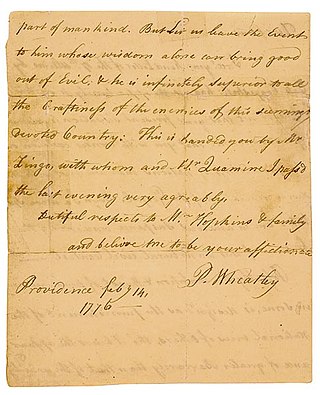
Obour Tanner, also spelled Abour or Arbour, was an enslaved African woman who lived in Newport, Rhode Island. Tanner was a regular correspondent of poet Phillis Wheatley, and the only correspondent of Wheatley's that was of African descent. Tanner acted as an agent for Wheatley in Newport and made the largest known order of Wheatley's Poems on Various Subjects, Religious and Moral in 1773.

Rhode Island Slave History Medallions, or RISHM, is a statewide non-profit organization based in Newport, Rhode Island. RISHM's mission is to raise public awareness of Rhode Island’s dominant role in the institution of slavery. RISHM marks historic sites and homes with a bronze plaque, or medallion, in communities around the state connected to slavery, to commemorate lives of the enslaved, and open a dialogue for racial understanding and healing.


















